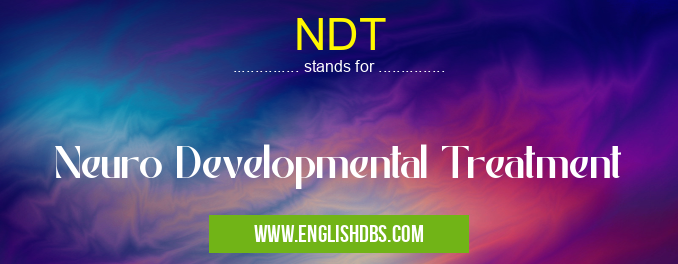What does NDT mean in NEUROLOGY
Neuro Developmental Treatment (NDT) is an evidence-based practice which focuses on the assessment and treatment of individuals with neurological impairments. It combines principles from physical, occupational, and speech therapies to address motor functioning difficulties in order to help improve the patient's ability to perform daily living activities. NDT has been used for many years as a successful method of rehabilitative therapy, and may be recommended by clinical professionals to patients of any age who are dealing with the effects of a number of neurological conditions or injuries.

NDT meaning in Neurology in Medical
NDT mostly used in an acronym Neurology in Category Medical that means Neuro Developmental Treatment
Shorthand: NDT,
Full Form: Neuro Developmental Treatment
For more information of "Neuro Developmental Treatment", see the section below.
Definition
NDT is an approach to treating neurological disorders that uses a holistic approach to evaluate and manage impairments caused by injury or disease. The methodology utilizes sensory integration, movement therapy, positioning, fine and gross motor training, along with other strategies in order to optimize function by assessing postural alignment, range of motion, balance, coordination, strength and dexterity. NDT also considers psychological factors like cognition and behavior when establishing goals for recovery.
Purpose
The goal of NDT is to help improve how well an individual can move their body parts in a coordinated manner so they can participate in functional activities more easily. This type of treatment aims to create improvements in mobility skills such as standing on one’s own two feet without assistance, being able to turn one’s head without feeling pain or discomfort, picking up objects from the floor without dropping them at first attempt; all these things contribute towards extra independence and overall quality of life for individuals living with neurological conditions or impairments.
Benefits
Aside from the obvious benefit that comes with improved mobility due to better coordination between limbs and body parts; another significant advantage that comes with Neuro Developmental Treatment (NDT) is increased self-esteem due to increased independence resulting from improved movements. As muscle strength improves through personalized exercises prescribed by trained therapists during NDT sessions - individuals begin experiencing equalization between their limbs which helps them feel more comfortable while performing everyday tasks such as getting dressed for work or school; walking up stairs or even playing sports where better coordination is beneficial. Since many medical practitioners now recognize NDT as a viable therapeutic option - those seeking assistance for related issues will find it much easier than before to find skilled professionals offering this service.
Essential Questions and Answers on Neuro Developmental Treatment in "MEDICAL»NEUROLOGY"
What is Neuro Developmental Treatment (NDT)?
Neuro Developmental Treatment (NDT) is a holistic approach to physical rehabilitation that is designed for patients with neurological and neuromuscular disabilities. Through specific treatment techniques, NDT focuses on improving the patient's ability to interact with their environment and function at their highest potential.
Who Practices NDT?
NDT is typically practiced by physical therapists, occupational therapists, and speech-language pathologists who have been trained in this specialized therapy approach.
What Are the Benefits of NDT?
The primary goal of NDT is to improve functional abilities such as mobility, coordination, and balance. Additional benefits can include improved sensory processing and communication skills; increased independence in activities of daily living; better posture; improved control of movement patterns; and enhanced safety awareness.
How Can NDT Help Children with Cerebral Palsy?
NDT can help children with cerebral palsy improve their gross motor skills, strength, endurance, balance, posture, coordination, and other areas. It can also be used to help reduce muscle spasticity while teaching children more efficient ways to move and complete tasks.
Is There Any Research about the Effectiveness of NDT?
Yes! There has been a growing body of evidence that supports the use of NDT for individuals with neurological or neuromuscular conditions such as cerebral palsy. Studies have shown positive outcomes related to improvements in range of motion, strength, balance/stability/endurance training gains after receiving NDT interventions.
How Long Does It Take to See Results from Receiving NDT Therapy?
Generally speaking, changes may not be seen immediately after beginning an intervention program using NDT techniques. As treatment progresses the therapist will be able to assess any progress made in terms of functional gains or improvements in quality of movement being performed by the patient.
What Is Involved During an ND Treatment Session?
During an ND treatment session a variety of tests are conducted to evaluate muscle strength and joint range-of-motion as well as observe how different challenges affect control or stability components involved in movement patterns attempted by the patient.
How Many Sessions Will I Need Before Seeing Results?
The number of sessions needed before seeing results varies depending on a variety of factors such as severity and nature (or chronicity) of the condition being treated as well as health status prior to beginning treatment.
Final Words:
Neuro Developmental Treatment (NDT) has been used for over 50 years as an effective way of helping patients achieve greater levels of independence despite facing various types disabilities or impairments related to neurological disorders - making it one concept within the medical field worth noting down! If you're looking for relief from any kind physical limitations brought about by your neurological condition - then perhaps this form rehabilitation might just be something worth looking into further down the line.
NDT also stands for: |
|
| All stands for NDT |
